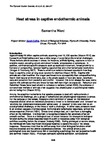Heat stress in captive endothermic animals
| dc.contributor.author | Ward, S. | |
| dc.date.accessioned | 2019-05-16T10:20:27Z | |
| dc.date.available | 2019-05-16T10:20:27Z | |
| dc.date.issued | 2013 | |
| dc.identifier.citation |
Ward, S. (2013) 'Heat stress in captive endothermic animals', The Plymouth Student Scientist, 6(2), p. 368-377. | en_US |
| dc.identifier.issn | 1754-2383 | |
| dc.identifier.uri | http://hdl.handle.net/10026.1/14046 | |
| dc.description | Approximately 26 billion captive animals, spanning over 10, 000 species (Mason 2010) are housed in artificial habitats and face a wide range of potential environmental challenges. These include abiotic sources of stress, for instance, artificial lighting, exposure to loud or aversive sound, arousing odours and uncomfortable temperatures or substrates. In addition, confinement-specific stressors such as restricted movement, forced proximity to humans or conspecifics, reduced feeding opportunities and other behavioural restrictions (Morgan & Tromborg 2007). There is enormous variation between species in how they react to captivity, even among close taxonomic relatives (Mason 2010). Captive wild animals are often healthier, live longer and breed more successfully than conspecifics living free in their natural environments, due to the ample supply of food and water, veterinary care and protection from predation and conflict. However, this is not always the case; some captive wild animals survive and breed far less well than might be expected. Behaviour and Darwinian fitness have been shown to correlate to welfare (Jordan 2005); the evidence of compromised welfare of animals often suggests that physiological or psychological needs are not being met (Mason 2010)... | en_US |
| dc.language.iso | en | en_US |
| dc.publisher | University of Plymouth | |
| dc.rights | Attribution 3.0 United States | * |
| dc.rights.uri | http://creativecommons.org/licenses/by/3.0/us/ | * |
| dc.subject | captive endothermic animals | en_US |
| dc.subject | heat stress | en_US |
| dc.subject | environmental challenges | en_US |
| dc.subject | natural environments | en_US |
| dc.title | Heat stress in captive endothermic animals | en_US |
| dc.type | Article | |
| plymouth.issue | 2 | |
| plymouth.volume | 6 | |
| plymouth.journal | The Plymouth Student Scientist |



